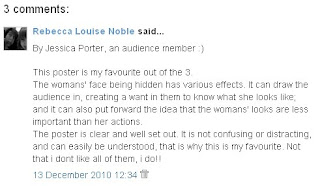‘String Along’ is a film that’s classed under a drama and romance genre. After creating the story of Delilah, the cheating woman, which was based on the theme of ‘The Fall’ I developed the idea into someone who loses everything by there own fault. Because of this story line, I knew the conventions I needed to successful portray from other films of the same genre and story. Studying films of the same genre I understood the narrative conventions that seemed to follow in most films about affairs or cheating. Getting caught is the continuous plot point in the large majority affair films, which was something I didn’t originally have in the idea for the story.In my first treatments the woman was never caught and her lack of commitment led to her fall. However I changed his plot point after feedback and further research into the genre, feeling we needed an event that would have a larger impact on both the character and the audience. A film we referred to for this idea was ‘Broken Embraces’ (2009). A Spanish film directed by Pedro Almodóvar, follows the genres of drama, romance and thriller. The main character Lena is caught between two men, one who she loves and one who provides for her. Similar to Delilah, expect her motives for her cheating is out of her greed. Also confrontation s eemed to be an important element to the same genre, films like Unfaithful (2002), were the partner becomes suspicious and the cheater is discovered.


It’s that confrontation that creates the dramatic themes to the film. However we’ve developed this idea further to create a moral message to the audience. We see how our character falls and lose everything because of her decision to cheat, rather than following the idea in Unfaithful, were in the end her marriage continues. With the door being left ajar in our film we’ve followed the idea of being caught red handed, however we had to forebode this happening through silence. Were as in a film like Unfaithful, the lies are discover through different characters dialogue, we had to present to the audience the inevitability of her end by actions. Leaving the door ajar, the use of the dropping thread and the fortune cookie are all to give the audience the clues and foreboding they would get with dialogue.
Our biggest development of the narrative of ‘String Along’ development was the use of the abstract world. By using it we created a thriller like atmosphere, gave a hint of thriller to the genre. Although we leave the abstract world open to audience interpretation, whether it’s a metaphor of Delilah, or a vision of her mind we developed it to portray the power she believes she has, and her struggle to keep it when confronted. I feel this created a stronger emotional understanding of the story.
This reminds me of the recent film ‘Black Swan’ (2010) which also uses the concept of abstract and fantasy like images to show the conflict and working of the main characters mind. This is to add a thriller pace to the drama. By using the abstract world we've tired to create this.
A challenge that our film creates to media products is the interpretation of the ‘red strings of fate’. Were the original folktale is how the string leads us to our soul mates, we challenged this idea by using the red string to portray Delilah’s connection to the men and to give her a puppeteer image over the men.

The use of character in ‘String Along’ uses many conventions inspired from existing media products. For the use of the two men, James and David we wanted them to be as different characters as possible. I found a common convention in films with similar themes is the woman’s desire for variety, or someone different from her present lover, present an idea of escapism. Such as in unfaithful, we see two men completely different in lifestyle and personality. This is something we tried to recreate. Making James the younger more love struck boyfriend, while David shows a suave lover character. Delilah’s representation herself is stereotypical of a promiscuous woman, our use of the red lipstick was based on the idea of geisha culture, who wore red lipstick to show her role as a geisha as well as to continue our theme of red. Our challenges of common portrayals of characters in drama/romances is our use of fast paced editing and our visual take on a film topic which is usually based on long scenes with dialogue. Also we attempted to make the relationship between characters less sexual with more focus to the emotional drama of cheating.
For sound we challenged the convention suspense music to fit the situation. Instead I used the soundtrack in a cycle affect, as the film draws near the end we see similar shots and scenes to show the comparison between before, and now that she’s alone. Using the mise en scene to show the clean, feminine room before, and the wrecked, messy room after, reflecting her emotions. We see the difference between the beginning and the end. This music cycle emphasizes that. We gained great inspiration from romance films for the mise en scene, films like indecent proposal use warm lighting, typical of the romance genre. Also the links of red and use of Chinese props was to emphasize the themes of the film, similar to romantic films mise en scene, which use colors and hues to create the romantic themes and atmosphere. Our abstract world, although challenging the genre of a typical romance film is inspired by Black Swan, and similar short films like Quietsch. It uses the ideas that are reminiscent of there lighting and arrangement. Overall String Along uses and challenges many conventions of the romance and drama genre, while including elements of thriller.





